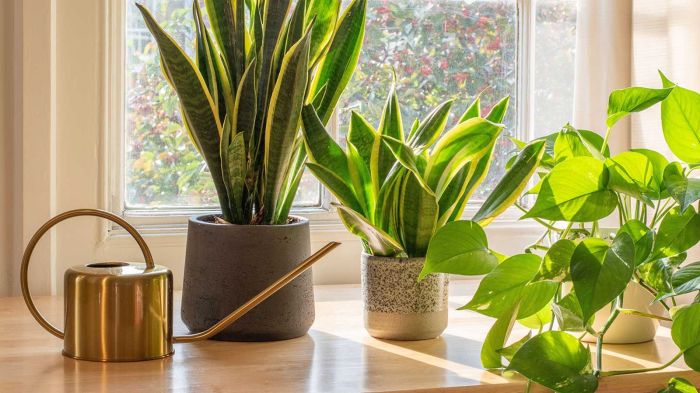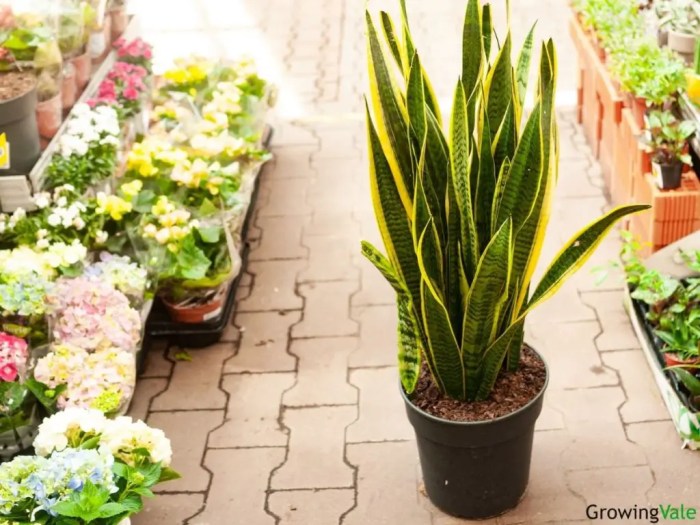How Much Should I Water Snake Plant?
Snake Plant Watering: A Comprehensive Guide
How much should i water snake plant – The snake plant, known for its resilience, still requires proper watering to thrive. Overwatering or underwatering can lead to serious problems, impacting its health and appearance. This guide provides a detailed understanding of snake plant watering needs, encompassing various factors, techniques, and troubleshooting tips to ensure your snake plant flourishes.
Understanding Snake Plant Watering Needs
Several factors influence how often you should water your snake plant. These include the size of the pot, the type of soil, the season, and the surrounding environment. Understanding these elements is crucial for maintaining optimal soil moisture.
Underwatering and overwatering manifest differently. Underwatering results in dry, brittle leaves that may droop or wilt. Overwatering, on the other hand, leads to root rot, yellowing leaves, and a mushy base. The following table compares the visual symptoms:
| Symptom | Underwatering | Overwatering |
|---|---|---|
| Leaves | Dry, brittle, wilting, curled | Yellowing, mushy, browning |
| Soil | Completely dry | Soggy, constantly wet |
| Plant Base | Firm | Soft, mushy |
| Root System | Healthy, firm | Brown, mushy, rotten |
The ideal soil moisture level for a snake plant is slightly moist but never soggy. The top inch or two of soil should be dry before watering again. Think of it as damp, not wet.
Watering Methods and Techniques
Several methods exist for watering snake plants, each with its advantages and disadvantages. Selecting the best method depends on personal preference and the plant’s specific needs.
- Top Watering: Pour water directly onto the soil surface until it drains from the drainage holes.
- Advantages: Simple, easy to perform.
- Disadvantages: Can lead to overwatering if not careful; may not evenly saturate the soil.
- Bottom Watering: Place the pot in a tray of water and allow the soil to absorb water from the bottom.
- Advantages: More even saturation; less chance of overwatering.
- Disadvantages: Slower process; may not be suitable for all pot types.
- Soaking: Thoroughly saturate the soil until water drains freely. Allow the soil to dry out completely before watering again.
- Advantages: Ensures deep and even hydration.
- Disadvantages: Risk of overwatering if not timed correctly.
Regardless of the method, always ensure excess water drains completely. Standing water in the pot’s saucer or bottom can lead to root rot.
Seasonal Watering Adjustments

Source: abanahomes.com
Watering frequency should vary with the seasons due to changes in temperature, humidity, and sunlight. Adjustments are necessary to prevent both underwatering and overwatering.
| Season | Watering Frequency | Reasoning |
|---|---|---|
| Spring | Every 1-2 weeks | Increased sunlight and warmer temperatures increase evaporation. |
| Summer | Every 1-2 weeks (possibly more frequently in hot, dry climates) | High temperatures and increased sunlight demand more frequent watering. |
| Autumn | Every 2-3 weeks | Reduced sunlight and cooler temperatures decrease evaporation rates. |
| Winter | Every 3-4 weeks or even less | Low temperatures and minimal sunlight reduce the plant’s need for water. |
Snake Plant Variety and Watering

Source: futurecdn.net
Different snake plant varieties may have slightly different watering needs due to variations in leaf size, thickness, and root systems. While the general principles remain the same, minor adjustments are beneficial.
- Sansevieria trifasciata (Mother-in-Law’s Tongue): Tolerates slightly drier conditions than other varieties.
- Sansevieria cylindrica (Cylinder Snake Plant): May require slightly more frequent watering due to its thicker leaves.
- Sansevieria hahnii (Bird’s Nest Snake Plant): Being smaller, it tends to dry out faster and may need more frequent watering than larger varieties.
Observe your specific plant’s response to watering to fine-tune your approach. If the leaves appear dry and brittle, increase watering frequency. If they are yellowing or mushy, reduce it.
Troubleshooting Watering Issues
Improper watering can lead to several problems. Root rot, leaf discoloration, and wilting are common indicators of watering issues.
Reviving an underwatered snake plant involves thoroughly soaking the soil and allowing it to drain completely. For an overwatered plant, remove it from the pot, trim away any rotten roots, and repot it in fresh, well-draining soil. The following steps Artikel repotting a snake plant with root rot:
- Carefully remove the snake plant from its pot.
- Gently rinse the roots to remove excess soil.
- Trim away any mushy, brown, or rotten roots using sterilized pruning shears.
- Allow the roots to air dry for a few hours.
- Repot the plant in fresh, well-draining potting mix.
- Water sparingly after repotting.
Visual Aids for Understanding Watering, How much should i water snake plant

Source: growingvale.com
Imagine the ideal soil moisture level as a moist sponge. It’s not dripping wet, but it retains moisture. You should be able to squeeze a small amount of water from the soil, but it shouldn’t be saturated.
Determining the right watering schedule for your snake plant depends on several factors, including pot size and environment. Overwatering is a common issue, so less is often more. Thinking about the cost involved, it’s interesting to compare this to larger-scale water management; for example, consider checking out this resource on how much does a water filtration plant cost – the investment in clean water is significant, just as consistent, appropriate watering is key for a healthy snake plant.
Ultimately, understanding your plant’s needs is crucial for its longevity.
Healthy snake plant roots are firm, off-white, and have a slightly fibrous texture. Unhealthy roots, due to overwatering, are brown, mushy, and lack firmness. They may also have a foul odor. Underwatered roots will appear dry and brittle.
Query Resolution: How Much Should I Water Snake Plant
Can I use tap water for my snake plant?
It’s best to use filtered or room-temperature water, as tap water can contain minerals that may harm your plant over time.
How often should I check the soil moisture?
Check the soil moisture at least once a week, especially during warmer months. Stick your finger a couple of inches into the soil; if it’s dry, it’s time to water.
What if my snake plant leaves are drooping?
Drooping leaves can indicate either underwatering or overwatering. Check the soil moisture to determine the cause and adjust your watering accordingly.
My snake plant’s leaves are yellowing. What should I do?
Yellowing leaves can be caused by several factors, including overwatering, underwatering, or nutrient deficiencies. Inspect the soil and adjust watering accordingly. Consider repotting if necessary.





















